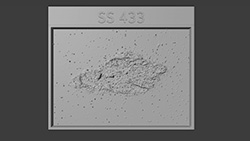Credit: X-ray: (IXPE): NASA/MSFC/IXPE; (Chandra): NASA/CXC/SAO; (XMM): ESA/XMM-Newton; IR: NASA/JPL/Caltech/WISE; Radio: NRAO/AUI/NSF/VLA/B. Saxton. (IR/Radio image created with data from M. Goss, et al.); Image Processing/compositing: NASA/CXC/SAO/N. Wolk & K. Arcand
The microquasar called Stephenson and Sanduleak 433, or SS 433, sits in the center of the supernova remnant W50 in the constellation Aquila, some 18,000 light-years from Earth. SS 433’s powerful jets, which distort the remnant’s shape and earned it the nickname the “Manatee Nebula,” have been clocked at roughly 26% of the speed of light, or more than 48,000 miles per second. Identified in the late 1970s, SS 433 is the first microquasar ever discovered.
These images of the Manatee Nebula show the jet emanating from SS 433, a black hole pulling material inwards that is embedded in the supernova remnant which spawned it. Radio emission from the supernova remnant are shown along with X-ray from IXPE, XMM-Newton and Chandra, along with infrared data from WISE.
(3D Print Credit: NASA/CXC/A. Jubett, using software by Tactile Universe/N. Bonne & C. Krawczyk & Blender)
Return to: NASA's IXPE Helps Researchers Maximize 'Microquasar' Findings (January 17, 2023)









